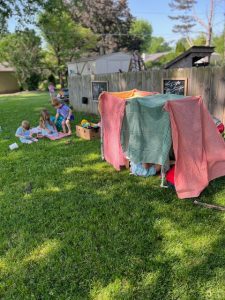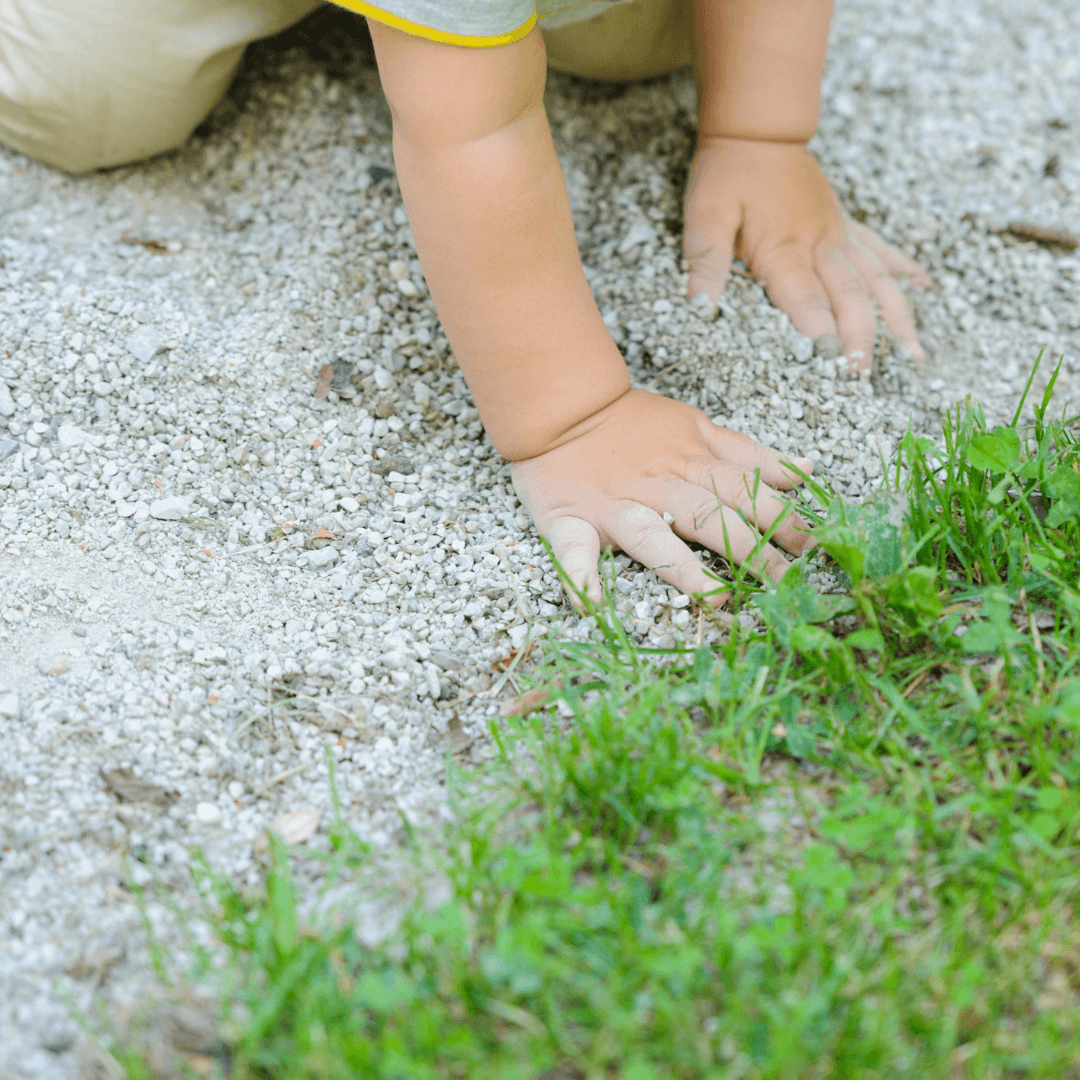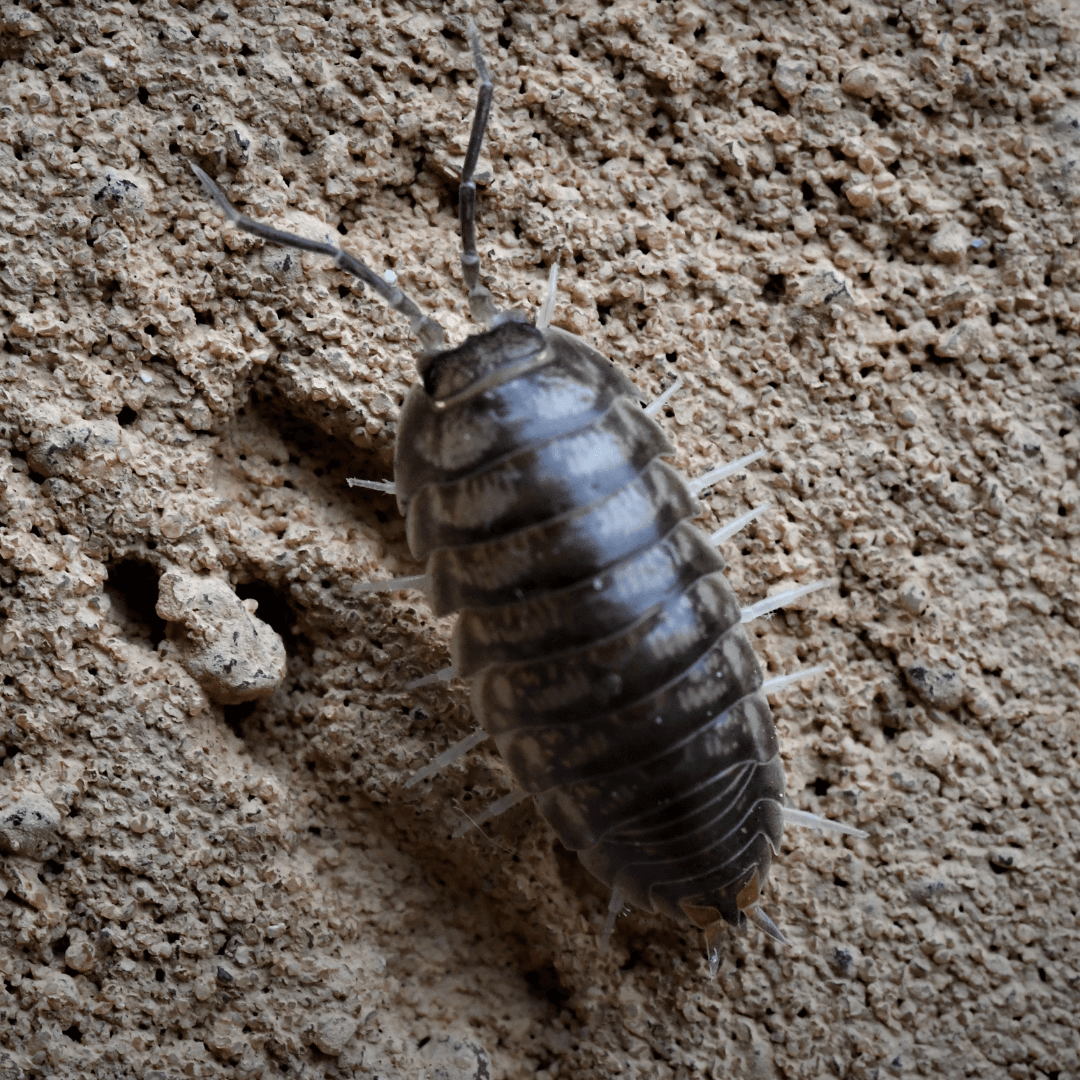Sometimes, if we take a moment to pause and look around (yes, it is hard to do!)…we can really see what is around us. We may realize that many of the answers to questions we ask are already there for us, just waiting to be discovered.
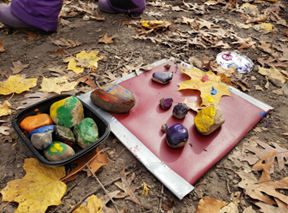 As early childhood educators and professionals, this pause may be through the process of asking a question in a new way, looking for a different outcome, truly seeing with new understanding. Or it may be a stepping stone for something we already know, but takes us into an unexplored direction.
As early childhood educators and professionals, this pause may be through the process of asking a question in a new way, looking for a different outcome, truly seeing with new understanding. Or it may be a stepping stone for something we already know, but takes us into an unexplored direction.
The journey of outdoor learning is like that.
For those that are already on this path, you know. For those curious and wanting to learn more, I invite you to read on.
Every outdoor environment has something to offer. Something to discover. Something new that can enrich our lives. It can transform the way in which children interact with the world. Our world. Their world.
The research is abundant and clear regarding the many benefits of children’s outdoor learning and nature play.
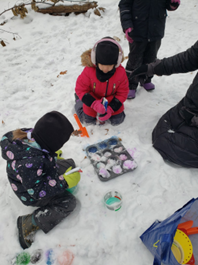 So, whether you have extensive or minimal outdoor time at your center, whether you have a forested area, a field, an open lot, or a small space or even just a few trees in which to explore, nature learning CAN happen. But, I stress that it be explored with that curious mindset. If you are thinking of all of the barriers that may stop you from implementing outdoor experiences for your children, you are not alone. But this is so new, so different! I have so much built into what I already know and do! This is too much work! Change IS hard, but as you read on for practical tools and ideas to integrate more nature into your day, you will find it is not only doable, but full of unexpected gifts. Getting Started Teaching Outside from Get toGreen through Fairfax County schools provides straightforward tips.
So, whether you have extensive or minimal outdoor time at your center, whether you have a forested area, a field, an open lot, or a small space or even just a few trees in which to explore, nature learning CAN happen. But, I stress that it be explored with that curious mindset. If you are thinking of all of the barriers that may stop you from implementing outdoor experiences for your children, you are not alone. But this is so new, so different! I have so much built into what I already know and do! This is too much work! Change IS hard, but as you read on for practical tools and ideas to integrate more nature into your day, you will find it is not only doable, but full of unexpected gifts. Getting Started Teaching Outside from Get toGreen through Fairfax County schools provides straightforward tips.
The North American Association for Environmental Education (naaee) offers three categories to plan for and organize outdoor learning experiences; TEACHING, SAFETY and the ENVIRONMENT.
When we are spending time outside with children, we can learn from both the space and the place. Learning outdoors (simply being outside!) is also a stand-alone benefit to whole-child development…simply being outside is good for children and schools.
- What do I teach?Natural Start: The Teaching and Tinkergarten: Tinkergarten outdoor learning ideas
- It seems so risky! Natural Start: The Safety
- Where? Natural Start: The Environment
Practical tips for clothing and snack time:
Sometimes starting small is best. A new nature walk routine with prompts such as “Tell me more about what you notice” and “Can you say more about that?” Or integrating a math focus such as “Nature explorers, today we are going to notice the nature around us in groups of three” may be one of the most important changes you make this year.
Sometimes re-thinking a routine typically done indoors and/or on a screen and bringing it outside, is best. Read-alouds, journaling, and songs may now take place on foam sit-upons or a tarp. Some extra minutes teaching and practicing outdoor learning routines are well worth the time.
Sometimes planning with your teaching team and doing your own adult nature-scavenger hunts, and surveying the areas for safe and creative play, is what is best.
Nature is joyful. Nature is powerful. Nature is an incredible teacher. I invite you to take the small steps or giant leaps needed in order to provide critically important outdoor experiences for our children. Working as a teacher and coach in countless spaces and places for over twenty years, I can truly say that what nature as a teacher gifts to us, is incomparable.
So, slow down, look around, and ask those questions that nature has been waiting for us to ask.
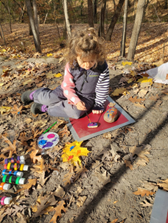 “If we truly want to make nature-based education meaningful and accessible for all children and families, we must strive to approach education in the context of not just the class, or the forest, but the place, this entire remarkable world of which we are all a part.” – Kit Harrington
“If we truly want to make nature-based education meaningful and accessible for all children and families, we must strive to approach education in the context of not just the class, or the forest, but the place, this entire remarkable world of which we are all a part.” – Kit Harrington
Early Childhood Education can have a lot of buzzwords and misunderstandings. This “Philosophy Spotlight” series intends to introduce you to the origins of a number of currently used philosophies directly from the writings of their founders and accomplished practitioners, as well as modern practices and ideas associated with these philosophies. Note that many of the philosophies and philosophers we reference in the US are Euro-centric in origin. I will do my best to integrate philosophies of development and learning from a more diverse body of knowledge, for the benefit of all children and providers. You’ll notice a significant amount of overlap between philosophies, as well as some stark differences. Use these articles to consider your own approach to early education, and maybe refine how you see you work and design your program. These are intended to be broad overviews; please see the references if you’d like to learn more about each one!
Modern Regulating Bodies/Standards:
In the UK, there is the Forest School Association that accredits Forest Schools/Nature Based Programs
Eastern Region Association of Forest and Nature Schools offers teacher certifications.
There is no requirement to be affiliated with these or other regulating bodies to call a program a Forest or Nature School.
Origins, Theories and Theorists:
Forest schools have existed around the world since the early 1920s, with Sweden and Denmark beginning the practice as a type of informal early childhood education. It has expanded substantially in recent years, notably since 2012 and another expansion during and after the start of the COVID-19 pandemic, particularly in Western Europe, Eastern Asia, and the United States.
From UK Forest School:
- Forest school is a long-term process of frequent and regular sessions in a woodland or natural environment, rather than a one-off visit. Planning, adaptation, observations and reviewing are integral elements of Forest School.
- Forest School takes place in a woodland or natural wooded environment to support the development of a relationship between the learner and the natural world.
- Forest School aims to promote the holistic development of all those involved, fostering resilient, confident, independent and creative learners.
- Forest School offers learners the opportunity to take supported risks appropriate to the environment and to themselves.
- Forest School is run by qualified Forest School practitioners who continuously maintain and develop their professional practice.
- Forest School uses a range of learner-centered processes to create a community for development and learning.
Values:
Providers with outdoor/nature based programs value being outdoors in almost all weather.
Leaving nature as it is– stewardship of nature.
Following the seasons; helping children observe the way the world changes over time and in predictable ways.
Some nature programs teach children from a young age how to use a campfire to cook or use other tools to interact with the outdoors. A degree of risky play is often a draw of Forest Schools or Nature Based Programs, whether that’s allowing children to climb trees or rocks, or carry and play with fallen sticks.
A Forest School is distinct from other outdoor play due primarily to time spent outdoors, in amount each day as well as the length of time in months or years in one place. There is also great freedom of time and flexibility of schedule, rather than preplanned and limited time to be outdoors.
What You Might Observe in a Forest School:
Children outside in all weather conditions.
Children out of view of supervising adults.
Adults setting children’s boundaries at the beginning of each session, reminding them how far and in what areas they can explore, what the signal is to return, and where to come back together at that signal.
Risky play, including children using tools.
Few to no traditional toys or play materials.
Influence on Modern ECE Programs at Large:
The Forest School movement has drawn attention to the benefits of time in nature for children and people of all ages, in physical health, mental health, and cognition.
Questions for Your Reflection:
How do I use my outdoor space and time?
What opportunities do children in my program have to notice daily, weekly, and seasonal changes?
What natural resources are available to me and the children in my care?
Fort building is an activity most children enjoy– who wouldn’t love the opportunity to be the architect of their own space? It’s also an incredible way to promote children’s creativity, imagination, persistence, and STEAM skills.
Why is this a STEAM activity?
Science: children need to navigate the physical properties of a variety of materials to make their fort. Will the fabric keep its shape when draped over sticks, or will it fold in ways the children didn’t anticipate? Will rubber bands be strong enough to hold the sticks together, or will they need to use yarn or glue?
Technology: Older children can use rulers, measuring tape, levels, and more tools to help them plan and execute their forts.
Engineering: Structural engineers need to take into account the materials they’re working with when designing structures for an intended purpose. These young engineers will learn the foundational problem-solving skills when the plan and test their designs.
Art: A sense of aesthetics is crucial in fort design! Children can select their color scheme and decor as they assemble.
Math: Geometry is key here, as children figure out how large a space they need to fit the people they would like inside, and measure their sticks and cloth accordingly.
Building outdoor fabric forts promotes play can help children develop problem-solving skills that will help them later in life. Fabric forts don’t always work out the way kids want them to! They teach children to find new and better ways to achieve the result they want.
How can you get started? Depending on the ages of the children involved, this activity may use: blankets, tablecloths, sticks, lengths of PVC pipe, yarn, glue, paper, rubber bands, and all kinds of other “stuff” that you have on hand!
In the book The Last Child in the Woods, Richard Louv (2005) links the lack of nature in the lives of children to being part of a “wired generation.” He says attention disorders, depression (yes, in children), and more disorders are all due to a “Nature Deficit.” This is an amazing book and a great resource for teachers. I encourage you to read it and bring more nature into your work with children
Kids love to dig and what’s more exciting than finding a Roly Poly? Supply the kids with shovels, magnifying glasses and bug containers and let them go to work. I purchased all of my supplies at the Dollar Store making it very reasonably priced. You could use recycled food containers and spoons found in your kitchen if you don’t have access to these materials.
Here are some fun facts about roly polies that you may not know:
- They are found in most regions of the world and live in moist dark areas, under rocks, bark, leaves and logs.
- They like to eat decaying plants or other vegetation. (What other creatures eat this type of food? Extend your science activity by setting out a fresh carrot with a rotten carrot and see which one the Pill Bugs will eat.)
- Pill bugs have three body parts, seven pairs of legs, two antennae and two eyes. They are ¼ to ½ of an inch in length and can roll into a ball when frightened. These are great facts to discover with your children. Bring out the magnifying glasses!
- Pill bugs are actually not bugs, they are crustaceans. They are related to shrimp and crayfish, breathe with gills, and need humidity or moisture to survive. You can explore other types of crustaceans with children as well.
- The pill bug goes through two stages of development: egg and adult. The female can lay up to 100 eggs, which are held in a pouch (like a kangaroo). After about two months as an egg, they hatch and emerge as a tiny adult. They grow by molting (shedding their skin) and can live up to three years. Good information to research with children. Try checking out a book about pill bugs.
You can explore habitats of all kinds of animals, bugs, or crustaceans. Try creating a roly poly habitat with children out of found materials. However, you also want to help children respect animals and their natural habitats. So make sure they know you ALWAYS put animals back in their natural habitats at the end of every day.

